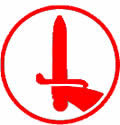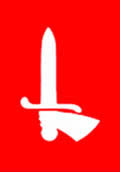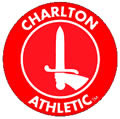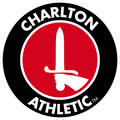Charlton Athletic
In 1905 a group of young boys - average age 15 - started playing under the name of Charlton Athletic FC on fields in the shadow of the giant Siemens Telegraph Works, now long demolished, and near where the Thames Barrier now stands. Some of the players worked in a fish and chip shop owned by Arthur Bryan who took to attending matches in his straw boater and apron, waving a smoked haddock on the end of a stick (no doubt to publicise his business). Bryan's antics led to a journalist describing him as "The Addicker" ("addick" is cockney for "haddock"): this was contracted to "Addicks," which became the club's nickname. Although it was dropped after a while, this distinctive moniker has been revived in recent years.
The team proved so successful that they joined the Lewisham League in 1906 but they remained essentially a strong local side until after the Great War.
Having had various homes before the war, in 1919 the club decided to create a permanent home in a disused chalk pit in the heart of Charlton village. An army of volunteers armed with picks and shovels dug out the quarry to create towering banks on either side of the pitch, suitably named The Valley. Facilities were rudimentary in those early days - there was no fencing, seating nor even concrete terracing and certainly no protection from the weather. Charlton Athletic joined the Kent League that year and in 1920, having turned professional, they were elected to the Southern League Second Division. In May 1920 the entire Southern League First Division was incorporated into the Football League as Division Three, which meant that Charlton were now members of the rump Southern League Division One. A year later, following the formation of Division Three (North), two vacancies were created in Division Three (South) and Charlton were comfortably elected. It may be argued that the club's rise to the national stage owed more to good fortune than achievements on the playing field.
By 1922 a new West Stand had been built at The Valley and the ground was being mooted as a venue for future FA Cup Finals, having a capacity of around 75,000. Falling attendances prompted the directors to move to a new ground at The Mount in Catford. For the 1923-24 season, Charlton wore the dark and light blue sripes of Catford South End FC with whom it was proposed to merge but it soon became obvious that there was no future in this development and the "Addicks" returned to the Valley at the end of the season. In 1926 Charlton had to apply for re-election but there were no applications from non-league clubs that year so they were returned unnopposed. In 1929 Athletic were promoted to Division Two but were relegated four years later.
In 1935 Charlton were promoted to Division Two once again and began a march that would take them to the pinnacle of English football. In 1936 they finished a point behind Manchester United to secure promotion to Division One for the first time. The following seasons they finished 2nd (1937), 4th (1938) and 3rd (1939) in the First Division. Who knows what the club might have achieved if World War Two had not intervened?
intervened?
In 1946, Charlton lost to Derby County in the first post-war FA Cup Final. At the post match dinner manager Jimmy Seed assured the players that they could win the cup the following year. And so they did, beating Burnley in extra time. The team crest of the period, when they were known as "The Robins," was worn both in the league but not the FA Cup Final that season.
 In 1957 Charlton were relegated to Division Two where they remained for the next 15 years. Between 1964 and 1966 the players turned out in a smart all-white kit with red shoulder flashes. The Catford debacle aside, this is the only time that the club has abandoned the traditional plain red shirt format. The familiar hand and sword badge was designed in 1963 and first appeared on this smart white strip. The image evokes the club's nickname at the time, "The Valiants."
In 1957 Charlton were relegated to Division Two where they remained for the next 15 years. Between 1964 and 1966 the players turned out in a smart all-white kit with red shoulder flashes. The Catford debacle aside, this is the only time that the club has abandoned the traditional plain red shirt format. The familiar hand and sword badge was designed in 1963 and first appeared on this smart white strip. The image evokes the club's nickname at the time, "The Valiants."
In 1972, Charlton were relegated to the Third Division, came back up i n 1975, went down again in 1980 but were promoted back to Divison Two in 1981. Between 1972 and 1974, the sword motif appeared without a background disc and then, in 1975, was replaced by a monogramme embroidered onto the shirts. This was used until 1980 when the familar sword-and-hand badge was revived.
n 1975, went down again in 1980 but were promoted back to Divison Two in 1981. Between 1972 and 1974, the sword motif appeared without a background disc and then, in 1975, was replaced by a monogramme embroidered onto the shirts. This was used until 1980 when the familar sword-and-hand badge was revived.
 In 1984-85, the club faced bankruptcy as attendances dwindled and the decision was taken to quit the crumbling Valley. For the next five years, Athletic shared Crystal Palace's Selhurst Park and despite poor attendances, in 1986 the club was promoted to the First Division. In March 1989, chairman Roger Alwen announced that the club would return to the Valley but it was clear that the now derelict site would need substantial investment to bring it up to even the minimum standards required. Two years of wrangling followed before the local authority granted planning permission for the redevelopment. In the meantime the Addicks were relegated in 1990.
In 1984-85, the club faced bankruptcy as attendances dwindled and the decision was taken to quit the crumbling Valley. For the next five years, Athletic shared Crystal Palace's Selhurst Park and despite poor attendances, in 1986 the club was promoted to the First Division. In March 1989, chairman Roger Alwen announced that the club would return to the Valley but it was clear that the now derelict site would need substantial investment to bring it up to even the minimum standards required. Two years of wrangling followed before the local authority granted planning permission for the redevelopment. In the meantime the Addicks were relegated in 1990.
The club's crest was modified slightly in 1983, the outer ring being rendered in black. This style was used until 1986 when the previous design reappeared. Since 1991, the three coloured version has been favoured.
In August 1991, Charlton were forced to move in with neighbours West Ham United because work on their new ground was not complete. The contractors then withdrew and it was not until December 1992 that the club could return home, albeit with the east terracing closed and temporary seating on the west terrace. Over the next few years, with careful financial planning, the ground was steadily redeveloped to Premier League standards and a capacity of 20,000. In 1998, following an epic match with Sunderland in the play-off final, Charlton were promoted to the Premiership but were relegated at the end of the season. In 2000 they returned to the Premier League with the intention of staying. Now playing regularly to capacity home crowds of 25,000, plans to increase the Valley's capacity to 40,000 were announced in 2004.
At a time when other clubs were driven to the point of bankruptcy in the pursuit of success, Charlton were often held up as a model of steady, sustainable financial development. This reputation was severely damaged when it was revealed that they lost £13m in the 2007-08 financial year. The search for a buyer proved futile and the team found themselves adrift at the foot of the Championship from which they were duly relegated in 2009.
